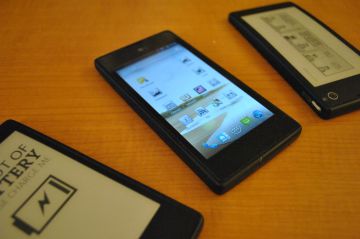New smartphones have been hard to find at CES, and the ones we have seen are short on innovative new features and long on incremental spec boosts. To find something truly different, I had to venture off the show floor for a private meeting with Yota Devices, the Russian company behind the upcoming YotaPhone.
The YotaPhone’s main attraction is a 4.3-inch E-Ink display that sits on the phone’s curved backside. The E-Ink screen allows users to keep certain types of information in view, such as the time, notifications or a photo, without draining battery life.
I was a bit skeptical of the YotaPhone when it was announced last month. The E-Ink display is unique on paper, but I wondered if it would seem too gimmicky in the real world. After seeing the YotaPhone up close, I’m starting to understand how the secondary display could be a really useful feature.
[youtube=”http://www.youtube.com/watch?v=NExrwY74ams”%5D
For one thing, Yota Devices sees the E-Ink display as a way to save us from our phones, as Microsoft once put it. If YotaPhone users can get accustomed to leaving their phones on a table or desk, with the E-Ink display facing up, they’ll be able to keep an eye on notifications without having to pick up the phone and fiddle with it.
“We believe strongly that with our phone we will bring people back to real life,” said Vladislov Martynov, CEO of Yota Devices.

Martynov brought up some other interesting possibilities: Because the phone can take a screenshot of anything on its main display and send it to the E-Ink screen, users could “print” boarding passes, so they’re out and ready when they get to the airport. That’d be more convenient than Passbook on Apple‘s iPhone, which requires users to keep their screens powered on and focused on the boarding passes. On a related note, Yota imagines that users could load their loyalty cards onto the phone so they’re ready to scan in E-Ink form.
The YotaPhone has a sense of humor as well. When you’re taking a photo and looking through the main screen, the E-Ink display tells everyone on the other side to smile for the camera.
In addition to all those built-in functions, Yota Devices will release software tools so third-party apps can take advantage of the E-Ink display. But as with any Android phone with unique hardware features, you can’t assume that app support will be widespread.
As for the actual phone, it runs a version of Android 4.1 that seemed pretty smooth in my hands-on time, though it did suffer the occasional app crash that I assume was just prototype blues. The tech specs are respectable, with a 4.3-inch 720p display, a dual-core 1.4 GHz Snapdragon S4 processor, a 13-megapixel camera, 2 GB of RAM and a minimum 32 GB of storage. The phone’s curved shape gets a bit chunky at its thickest point, where it measures 0.38 inches thick, but that’s to be expected given the extra E-Ink screen, and the curviness helps to add comfort at least.
The one thing that did irk me about the YotaPhone is its use of swipe gestures in place of Android’s basic home and back buttons. To return to the home screen, you swipe fully from right to left along the bottom bezel, and to go back, you swipe halfway. Perhaps this helps avoid accidental taps, but to me it just seems like an unnecessary extra step that risks confusing users.
Although Yota Devices isn’t known as a big smartphone brand, the company wants to launch the YotaPhone all over the world, including the United States. The company’s in talks with wireless carriers, and would consider producing variants of the YotaPhone if individual carriers demanded it. If all goes well, we might see the YotaPhone’s dual screens in finished form before the year is over.
MORE: Check out TIME Tech’s complete coverage of the 2013 Consumer Electronics Show

